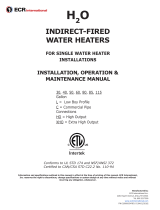
IMPORTANT
Do not attempt to use Method C to size a single-family
residence.
Method C: Commercial Sizing Method Directions
1) Table 5 and 6 show demands for various fixtures found in commercial buildings in
gallons per hour. To determine the hot water requirements of the building:
a) Using Worksheet 2, determine and record the total number of each type of fixture in
the building under Column (2)
b) Use Tables 5 and 6 to find the number of gallons of 140°F water used per hour per
fixture. Record this value for each fixture in Column (1).
c) Multiply each line in Column (1) by the number in Column (2). The result is the total
amount of water used for each type of fixture type per hour. Record this in Column
(3).
d) Total Column (3). The result is the total amount of water used by all fixtures per
hour. This is the possible maximum demand.
e) The demand factor is intended to take into consideration the fact that not all
fixtures will be in use at the same time. Use the appropriate demand factor from
Table 5. Multiply the total demand calculated in step (d) by this factor. The result is
the probable maximum demand.
f) If a commercial dishwasher or laundry is on the job, determine the maximum amount
of 140°F water, which could be used in an hour. This will depend upon the number
of machines, the amount of water used per machine and the way in which the
equipment is to be used. Consult the machine manufacturer and the building owner
for this information. Once the maximum hourly usage is known for this equipment,
enter it in the spaces provided under Column (3).
g) Add the hourly usage for dishwashers and washing machines to the Probable
Maximum Demand. This is the Adjusted Probable Maximum Demand. Select the
water heater
2)
a) If a new boiler is to be installed with the water heater, go to Table 1 and select a
water heater which has a 140°F first hour rating greater than or equal to the
Adjusted Probable Maximum Demand calculated in Method C step 1 g.
Determine the boiler size required to satisfy the space-heating requirement alone.
Note the gross output or Heating Capacity of this boiler. Compare the boiler's gross
output
required for the water heater and the gross output required for the space heating
(Gross output required for space heating = heating load x 1.15). Use the boiler
sized to the larger amount.






















